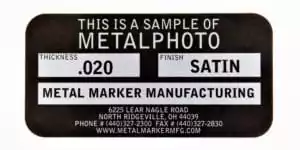In our modern cities and communities, we rely on access to utilities such as gas, electricity and water to ensure our homes can meet our basic everyday needs.
Energy organizations use meters to track each customer’s energy usage, ensuring accurate billing based only on the energy they consumed.
These devices are often marked with utility meter tags, which are metal identification tags that provide information to both servicers and customers.
What Is a Utility Meter Tag?
Utility meter tags are specialized identification tags that label and track utility meters for water, gas and electricity systems. These tags are a quick reference for essential information, such as meter identification numbers, service details and maintenance records.
Designed for ease of use and readability, utility meter tags are a key component in ensuring efficient operation and management of utility systems, helping utility providers and property owners stay organized.
Benefits
Using utility meter tags offers several advantages for both utility providers and end users:
- Improved Organization: Meter tags help streamline identification, ensuring each meter is correctly labeled and easily located.
- Enhanced Safety: Tags can include important warnings or usage guidelines to protect workers and property owners.
- Time Savings: With clear and accurate labeling, technicians can quickly access the information they need during inspections or repairs.
Utility companies can reduce errors, improve service reliability and enhance customer satisfaction by investing in quality meter tags.
Application
Inspections
Meter readings and inspections are extremely important to utility companies. Ensuring their equipment is accurately tracking utility usage is vital for their business. If the meter is not functioning properly customers can be under or over-billed. This can lead to a loss of revenue or unhappy customers.
Periodic inspections and readings of the meter also can detect any present issues with a service line. Third-party safety inspections may help audit any issues that the service provider may have missed.
Sometimes referred to as utility badges, metal tags are used to help organize and streamline the inspection process.
A custom nameplate adds basic information, such as the company name or meter number. This helps servicers keep track of which meters they have already serviced and indicate any repairs that need to be made.
In some cases, barcodes are added to the nameplates to provide a highly effective method for monitoring the asset. With a quick scan, data can be logged and updated to a tracking system.
Contact Info
Alongside servicing information, meters are commonly marked with contact information.
When there is an issue with utilities, customers want a fast response. If they don’t have the contact number handy, being able to check the meter for the number is a convenient alternative. This can prove to be even more useful in the event of an emergency.
For example, if there is a potential gas leak, first responders may want to contact the gas company for assistance in shutting down the source. Providing a contact number directly on the meter provides a quick method to get support when necessary.
Types of Utility Meter Tags
There are several types of utility meter tags, each suited for different applications:
- Locking Tags: These tags provide security by preventing unauthorized access to utility meters.
- Color-Coded Tags: This type helps categorize meters based on type, location or status for quick identification.
- Custom Engraved Tags: Manufacturers often include detailed information on these tags, such as serial numbers, barcodes or QR codes, to enhance the traceability of materials or equipment.
Each type can be customized to meet the specific needs of utility providers or property managers.
Durability
Durability is a critical feature of utility meter tags, as they often face exposure to harsh outdoor conditions. At Metal Marker, we manufacture high-quality tags to resist corrosion, fading and wear caused by UV rays, moisture or temperature fluctuations.
Marking Processes
Utility meters are exposed to the elements all year round. Any identification tag affixed to a meter must be ready to withstand the same level of abuse. Selecting a durable marking process helps ensure the tag will hold up to the same conditions.
Photo Anodization
When it comes to sheer versatility, the photo anodization process is hard to match. Offering full customization alongside top-notch durability, this is an all-around solid marking process.

Photo anodization embeds a design between layers of aluminum, providing an abrasion-resistant image. Built to endure 20+ years of outdoor exposure, this design is also engineered to withstand harsh weather conditions. As mentioned before, this resilience is crucial for meter marking.
Outside of durability, photo-anodized tags are completely customizable. Logos, contact information, and any other information can all be incorporated. Many utility organizations use this process to add a bar code or QR code. This allows servicers to quickly scan the meter to track and log information.
In addition to custom designs, anodized aluminum nameplates can include a solid background color. This is utilized for color coding (e.g., blue for the water meter, yellow for electricity, etc.) or branding purposes.
Photo-anodized tags are attached to meters using holes in the tag or applied using an adhesive backing.
Embossing/Stamping
For a more simplified meter nameplate solution, embossing and stamping are two solid options. These processes directly press information into the metal substrate.
Embossing elevates the design using a die set while stamping creates recessed information. This permanent identification is incredibly sturdy and will last many decades in outdoor environments.

Unlike photo anodizing, there are some limitations to the information that can be added to stamped or embossed nameplates. Custom logos are very limited and require a custom stamp or die set to be made.
These processes work best with basic letters and numbers. For example, embossed meter tags can be serialized for easy asset tracking and inspection.
Embossed and stamped nameplates are typically attached to a meter using a wire or directly mounted with hardware.
Plastic Tags
Some utility organizations utilize plastic tags to mark their meters. These tags can be pre-marked or blank for the operator to write information on. These ID tags are not nearly as durable as their metal counterparts and will not survive for extended periods of time in outdoor environments.
Sometimes, these tags are also attached to a meter seal, which indicates that the meter has been tampered with if it is removed.
Materials
The materials used to produce meter tags affect their longevity and functionality. Common options include:
- Aluminum: Lightweight yet durable, aluminum features excellent resistance to rust and corrosion, making it ideal for multiple applications.
- Stainless Steel: This material offers maximum durability and withstands extreme conditions, making it ideal for industrial applications.
- Brass: Known for its attractive appearance and excellent corrosion resistance, brass is a durable and malleable material often used in decorative or high-visibility applications.
Wrap-Up
Marking utility meters with metal identification tags is a simple but effective method of providing key information to servicers and customers.
The longevity of metal allows for the nameplates to hold up even when exposed to the outdoor conditions of energy meters. Contact our team today to learn more about options that can benefit your operations.